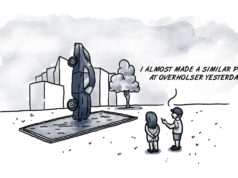
(Editor’s note: This post has been updated to include comment from Jack Fowler.)
The Office of Management and Enterprise Services released a statement this afternoon asking that two OKC residents abandon their future plans for projecting artwork onto a tarped section of the Oklahoma State Capitol.
Monday night, local artist Jack Fowler and technical guru Stephen Tyler projected a giant image of folk singer and Oklahoma icon Woody Guthrie onto tarps surrounding the scaffolding on the Capitol’s exterior northern side. In the image, Guthrie’s guitar featured the text, “How did it come to this,” replacing the iconic, “This machine kills fascists.”
By the Twitter and Facebook hashtags #WoodysGuitar, Fowler and Tyler have sought public suggestions for textual messages to be included on future iterations of the image. In an interview with NonDoc on Monday night, the pair said their intent was to repeat the stunt nightly “for a while.”
After today’s official statement from the Capitol, however, those plans for projecting artwork may have hit a snag. Below is the release from OMES director of public affairs Michael Baker in full:
We appreciate the creativity and ingenuity displayed by local artists last night, but it’s important to note that projecting images onto the State Capitol is prohibited without the necessary permits.
As for specifically projecting an image onto the tarps covering scaffolding, such action is prohibited due to safety concerns. Restoration crews are working at night and light can seep through the tarp material causing a distraction. Such distractions, when working many feet above the ground, can be extremely hazardous.
We would ask that future plans to project images onto the tarp be abandoned out of respect for workers’ safety.
Again, we appreciate the creativity displayed last night, but to repeat such action could have significant consequences, cause safety issues for crews working at night and is prohibited.
Reached around 3 p.m. Tuesday, Fowler questioned the logic of OMES’s prohibitive statement.
“I find it odd that they cited this light seepage and safety concern when they have two megawatt floodlights pointed at this tarp all night long,” Fowler said. “Either their lights are safer than my lights, or they are splitting hairs about freedom of speech in the most unusual place possible.”
Asked whether he planned to project his art again this evening as discussed, Fowler said “no comment.”






















